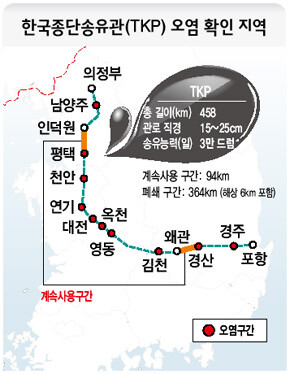hankyoreh
Links to other country sites 다른 나라 사이트 링크
Trans Korea Pipeline wreaks havoc on the environment

The soil in 10 out of 23 cities and municipal districts in which Trans Korea Pipeline has been installed has suffered severe contamination due to leaks from the pipeline, which supplies oil to U.S. military troops in South Korea.
The affected areas included Daejeon, Gyeongju and Pyeongtaek. The Ministry of Defense, which gained ownership of the pipeline from the U.S. Forces Korea in 1992, is currently making an effort to notify officials in the affected areas and clean up the contamination. Experts estimate that it will cost about 100 billion won (US$96.4 million) to dismantle the pipeline and clean up the land in the affected areas.
In 1969 and 1970, the USFK installed the 458-kilometer-long pipeline, which uses pipes with a diameter ranging from six to 10 inches, to transport petroleum products. The pipeline stretches from the southeastern port city of Pohang to Waegwan, Cheonan, Pyeongtaek and ends in Uijeongbu. Under an agreement with the U.S. Forces Korea, the South’s Defense Ministry decided to dismantle 79 percent of the pipeline, or 358 kilometers.
According to a survey of land contamination in the areas where the 358-kilometer section of pipeline is set to be dismantled the level of contamination due to oil leaks in 10 out of 23 sites exceeded the standards set by the Ministry of Environment. The affected sites are Gyeongju, Gyeongsan, Gimcheon, Yeongdong, Okcheon, Daejeon, Yeongi, Cheonan, Pyeongtaek and Namyangju. The survey was conducted by the National Environment Research Institute between September 2006 and June 2008 after being commissioned by the Defense Ministry. The Hankyoreh and the Green Korea, a civic group for environmental protection, obtained the survey after asking that the Defense Ministry and local governments release it.
In one zone in Sosa-ri, in the city of Cheonan, the research institute detected a concentration of 9889.8 milligrams of Total Petroleum Hydrocarbons, or TPH, a mixture of many different petroleum compounds, per kilogram of soil, which is more than 20 times higher than the Environment Ministry’s regulation for no more than 500 mg/kg.
In another zone in Sosa-ri, the research institute detected 5052.7 milligrams of TPH per kilogram of soil, about 10 times higher than what is permissible. There was also 5268.9 milligrams of TPH per kilogram of soil found at Godang-ri, Shimcheon-myeon, Yeongdong County. In July 2007, when the National Assembly conducted an investigation at Camp Edward, a U.S. military base in Paju, Gyeonggi Province, 2.4-meter-thick oil field had been detected, the level of TPH was 12,108 mg/kg.
Hwang Min-hyeok, an activist with Green Korea, said, “It’s expected to cost about 100 billion won to dismantle pipes and clean up the contamination, but it’s impossible to calculate the cost of restoring the environment. Under the agreement made by South Korea and the U.S., the South Korean government is required to pay all of the (clean-up) costs.” Hwang said.
Experts say it will cost 30 billion won to dismantle the pipeline and 40 to 60 billion won to clean up the contamination, while another 20 billion won will be needed to pay for unauthorized land use.
Please direct questions or comments to [englishhani@hani.co.kr]
Editorial・opinion
![[Guest essay] Amending the Constitution is Yoon’s key to leaving office in public’s good graces [Guest essay] Amending the Constitution is Yoon’s key to leaving office in public’s good graces](https://flexible.img.hani.co.kr/flexible/normal/500/300/imgdb/original/2024/0416/8917132552387962.jpg) [Guest essay] Amending the Constitution is Yoon’s key to leaving office in public’s good graces
[Guest essay] Amending the Constitution is Yoon’s key to leaving office in public’s good graces![[Editorial] 10 years on, lessons of Sewol tragedy must never be forgotten [Editorial] 10 years on, lessons of Sewol tragedy must never be forgotten](https://flexible.img.hani.co.kr/flexible/normal/500/300/imgdb/original/2024/0416/8317132536568958.jpg) [Editorial] 10 years on, lessons of Sewol tragedy must never be forgotten
[Editorial] 10 years on, lessons of Sewol tragedy must never be forgotten- [Column] A death blow to Korea’s prosecutor politics
- [Correspondent’s column] The US and the end of Japanese pacifism
- [Guest essay] How Korea turned its trainee doctors into monsters
- [Guest essay] As someone who helped forge Seoul-Moscow ties, their status today troubles me
- [Editorial] Koreans sent a loud and clear message to Yoon
- [Column] In Korea’s midterm elections, it’s time for accountability
- [Guest essay] At only 26, I’ve seen 4 wars in my home of Gaza
- [Column] Syngman Rhee’s bloody legacy in Jeju
Most viewed articles
- 1[Guest essay] Amending the Constitution is Yoon’s key to leaving office in public’s good graces
- 2Faith in the power of memory: Why these teens carry yellow ribbons for Sewol
- 3[Editorial] 10 years on, lessons of Sewol tragedy must never be forgotten
- 4[Guest essay] How Korea turned its trainee doctors into monsters
- 5How Samsung’s promises of cutting-edge tech won US semiconductor grants on par with TSMC
- 6US grants Samsung up to $6.4B in subsidies for its chip investments there
- 7[News analysis] Watershed augmentation of US-Japan alliance to put Korea’s diplomacy to the test
- 8Korea ranks among 10 countries going backward on coal power, report shows
- 9[Column] A death blow to Korea’s prosecutor politics
- 10K-pop a major contributor to boom in physical album sales worldwide, says IFPI analyst